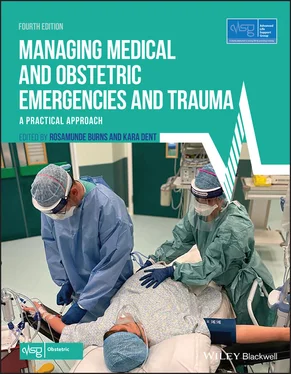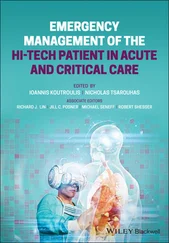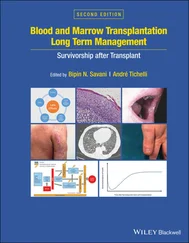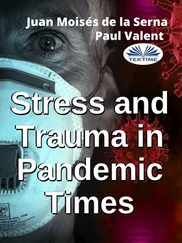Source : (a) Courtesy of Trauma Victoria – Obstetric Trauma guideline. http://trauma.reach.vic.gov.au/
To prompt manual uterine displacement (MUD) early in the process of resuscitation, remember:
‘Hello. How are you Ms MUD?’
Shock can be classified into four types:
Hypovolaemic shock
Cardiogenic shock
Distributive shock
Obstructive shock
In order to differentiate between these types of shock, clues can be gained from the history, examination, selected additional tests and the response to treatment.
Hypovolaemic shock: insufficient preload
Absolute loss of fluid: e.g. haemorrhage
Relative loss of fluid: vasodilatation, e.g. spinal/epidural anaesthesia
Absolute hypovolaemia – blood loss, fluid loss
This form of shock is due to a drop in the effective circulating volume resulting in a decrease in venous return. This causes a drop in stroke volume. There is usually a compensatory increase in heart rate to preserve cardiac output and also a compensatory increase in vascular resistance. This vasoconstriction, mediated by endogenous catecholamine release, increases the diastolic pressure without having the same effect on the systolic pressure thus there is a narrowed pulse pressure. Compensatory fluid shifts occur from the extravascular space into the vascular compartment, resulting in intracellular dehydration and a sensation of thirst.
Important implications of pregnancy physiology in haemorrhage
During pregnancy there is an increase in circulating blood volume of approximately 40% due to increases in both plasma and red cell volume. In a 70 kg woman, blood volume in pregnancy increases from 70 to 100 ml/kg (from 4900 to 7000 ml). This circulating volume enables the pregnant woman to lose 1200–1500 ml of blood before demonstrating any signs of hypovolaemia (35% of her circulating blood volume). This enhanced ability to compensate for blood loss increases our risk of underestimating the severity of blood loss, occasionally even until the point of maternal collapse.
Relative hypovolaemia – vasodilatation due to regional blockade
Intrathecal and to a lesser extent epidural local anaesthetics block the sympathetic nervous system, resulting in vasodilatation and hypotension. Usually there is a compensatory tachycardia associated with a fall in diastolic pressure. Subsequently, systolic blood pressure falls earlier than would occur during actual blood loss.
This sympathetic blockade exacerbates other simultaneous causes of hypotension such as haemorrhage and results in earlier decompensation.
A ‘high’ spinal will also affect the sympathetic nerves controlling the heart rate, causing a bradycardia and profound hypotension.
Cardiogenic shock – reduced cardiac contractility
Causes of cardiogenic shock include:
Ischaemic heart disease
Cardiomyopathy
Arrhythmias
The distinguishing features of cardiogenic shock include orthopnoea and signs of pulmonary congestion, such as a raised jugular venous pressure, reduced oxygen saturation and basal pulmonary crackles. Symptoms and signs such as shortness of breath, chest pain, syncope, sweating, cool peripheries and tachycardia occur but are not specific to cardiogenic shock.
Distributive shock – abnormal vascular resistance and fluid distribution
The following pathologies can result in distributive shock:
Sepsis
Anaphylaxis
Burns
In this form of shock (see Chapter 7), the patient will have signs and symptoms of systemic inflammation as well as those of the disease causing the sepsis. The pathological process is profound vasodilatation and hence these patients may have warm peripheries, particularly early in the process, despite being in shock. There is a compensatory tachycardia and increase in cardiac output to maintain perfusion pressure.
Varying degrees of organ dysfunction are seen, depending on the duration and degree of sepsis. In advanced stages of shock, the septic patient will become vasoconstricted, with cold extremities.
Anaphylaxis is a severe, life‐threatening, generalised, systemic hypersensitivity reaction to a trigger agent in which histamine, serotonin and other vasoactive substances are released. Anaphylactic reactions usually begin within 5–10 minutes of exposure to the trigger and the full reaction usually evolves within 30 minutes.
If anaphylaxis is suspected, samples for serial serum tryptase estimations should be taken. The enzyme tryptase is released from mast cells and it parallels histamine release. Peak concentrations well above 20 ng/ml indicate a true anaphylaxis/anaphylactic reaction. The peak value occurs anywhere between 30 minutes and 6 hours after exposure. Samples must be taken at the time of the acute event when the patient is stable, 1–2 hours later and a further sample at >24 hours.
Later investigation, after the acute event, involves skin testing to identify the presence of specific immunoglobulin E (IgE) antibodies. The value of skin tests, and especially the prick test, has been shown in extensive studies.
There are estimated to be 500 severe reactions in the UK each year. The estimated obstetric perioperative incidence of life‐threatening allergic reactions is 3.4 per 100 000 anaesthetics (from the Royal College of Anaesthetists National Audit 6 published in 2017 (Kemp et al., 2017) or 1.2 per 100 000 maternities. This is significantly lower than the incidence in non‐obstetric adult cases of 1 in 10 000 anaesthetics. The most frequent trigger agents perioperatively were antibiotics, neuromuscular blocking agents, chlorhexidine and patent blue dye. Anaphylaxis presented within 10 minutes of exposure to the triggering agent in 83% of cases; chlorhexidine and Patent Blue dye cases were slower to present. Hypotension was the presenting feature in 46% of the anaphylaxis cases and occurred during the reaction in all cases. Bronchospasm occurred in 49%. Urticaria and flushing were uncommon presenting features and skin signs were uncommon in the more severe reactions, sometimes only occurring after resuscitation. When the obstetric cases were examined the majority of patients were awake at the time of the reaction and complained of ‘feeling unwell’ before the onset of hypotension. Recognition of a critical event was prompt but recognition of anaphylaxis and starting anaphylaxis‐specific treatment was slower than in non‐obstetric cases. The report comments that this may have been because of the wider differential diagnosis for hypotension in the obstetric setting and that anaphylaxis was low on the list. Adrenaline was administered notably less often than in non‐obstetric settings, which may have reflected the availability of phenylephrine in the obstetric setting. Maternal and neonatal outcomes were good however and there were no cardiac arrests.
The direct effect of the burn causes fluid loss from the body leading to hypovolaemic shock. In addition, inflammatory mediators are released causing a massive leak of fluid into the tissues, resulting in a problem of distribution. This topic is discussed further in Chapter 22.
Obstructive shock can result from the following:
Massive pulmonary embolism (see Chapter 13)
Cardiac tamponade (see Chapter 17)
Tension pneumothorax (see Chapter 17)
This form of shock is due to a reduction in venous return to the heart. Patients, if conscious, are very dyspnoeic and struggle to sit upright, gasping for breath. Extreme tachycardia is a compensatory mechanism for compromised cardiac output. There will also be associated features of the pathology causing the obstruction of blood flow.
Читать дальше












